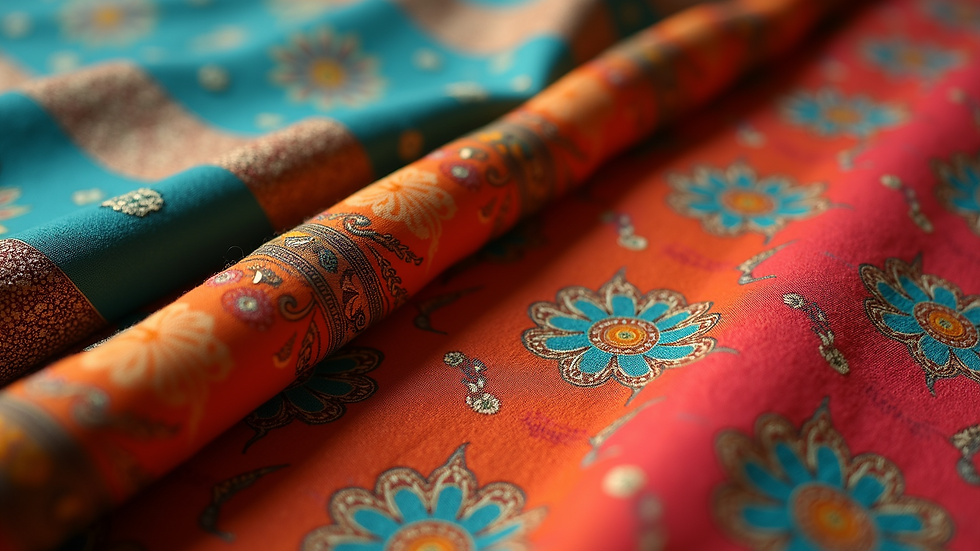A Deep Dive into the World of Indian Sarees
- Amzi

- Jul 20
- 4 min read
Indian sarees are not just a piece of clothing; they are a beautiful reflection of the country’s diverse culture, traditions, and heritage. They have been worn for centuries and come in various styles, fabrics, and colors. Each region in India has its unique saree weaving tradition. Let’s explore the fascinating world of Indian sarees and the timeless elegance they embody.
Indian Sarees: A Symbol of Heritage
The saree is a versatile garment made of a long piece of fabric, typically ranging from five to nine yards in length. Traditionally, it is draped around the body and can be styled in numerous ways. The saree's history dates back to the Indus Valley civilization, making it over 5,000 years old.
The significance of sarees transcends mere attire; they are integral to Indian rituals, celebrations, and daily life. In many cultures, wearing a saree is a rite of passage for women, marking milestones such as marriages and festivals.

The design and fabric of a saree often vary by region. For instance, the Banarasi sarees from Varanasi are known for their intricate gold and silver brocade, while Kanchipuram sarees from Tamil Nadu feature vibrant colors and unique weaving techniques.
The Different Types of Indian Sarees
When it comes to sarees, the diversity is staggering. Here are some popular types you should know about:
1. Banarasi Sarees
Banarasi sarees are famous for their rich texture, luxurious fabric, and opulent embroidery. Made primarily from silk, these sarees often feature intricate gold or silver zari work.
2. Kanchipuram Sarees
Originating from Tamil Nadu, Kanchipuram sarees are known for their bright colors and heavy silk material. Each saree is woven using pure silk, and they often have borders that are woven in contrasting colors.
3. Chanderi Sarees
Coming from Madhya Pradesh, Chanderi sarees are lightweight and feature ornate motifs. They are made from a mix of silk and cotton, making them perfect for both day and evening wear.
4. Bandhani Sarees
Bandhani sarees are recognized by their tie-dye technique, originating from the Kutch region of Gujarat. The intricate patterns created through this method make each piece unique.
5. Nauvari Sarees
Nauvari sarees, also known as Maharashtra sarees, are typically worn by women in a traditional nine-yard style. They offer a unique draping style that does not require a petticoat.
These are just a few examples; the variety is endless. Each saree tells a story, reflecting the artistic heritage of the region it comes from.

How to Style Indian Sarees
Wearing a saree can seem daunting if you are unfamiliar with it. Here are simple tips to help you style your saree elegantly:
Draping Style: There are numerous ways to drape a saree, with the most common being the Nivi drape. Experimenting with different draping styles can help you find what suits you best.
Accessorizing: A saree can be elevated with the right accessories. Statement jewelry, such as chunky necklaces and jhumka earrings, can add a glamorous touch.
Footwear: Pair your saree with stylish footwear. Traditional juttis or elegant heels can complete your look effectively.
Blouse Fit: The blouse plays a crucial role in enhancing the overall look of your saree. Consider flared, off-shoulder, or backless designs to create a stunning appearance.
Fabric Choice: The fabric of your saree can significantly affect your comfort. Cotton sarees are ideal for hot weather, while silk sarees fit well for festive occasions.
The Craftsmanship Behind Indian Sarees
The making of a saree involves tremendous skill and artistry. The craftsmanship varies from region to region, often employing age-old techniques that are passed down through generations. For example, the Banarasi weavers use intricate handloom weaving techniques that require years of training.
According to statistics from the Indian Ministry of Textiles, over 35 million people are involved in handloom weaving across India. These artisans play a crucial role in preserving the rich textile heritage of the country. Their expertise ensures that each saree is not just a garment but a work of art.

The Significance of Sarees in Modern Fashion
In recent years, Indian sarees have made a prominent mark on the global fashion scene. Designers are reinterpreting traditional sarees to cater to contemporary tastes. Innovative fabrics and designs are emerging, making sarees a popular choice for both festive occasions and everyday wear.
Many celebrities and fashion influencers are embracing sarees, introducing them to younger generations. The trend of "designer sarees" emphasizes the blend of traditional motifs with modern cuts and styles. You can explore a collection of such sarees here: designer sarees.
The fusion of old and new in sarees allows women to express themselves creatively. This revival highlights the versatility of the saree, ensuring it remains a favored garment in contemporary fashion.
Wrapping Up the Journey of Indian Sarees
Indian sarees hold a special place in the heart of every woman. They represent a connection to culture, heritage, and individuality. The unique qualities of each saree make it a piece of art that can be worn with pride.
As you explore the world of sarees, remember to appreciate the artistry and craftsmanship behind each piece. View sarees not only as clothing but as expressions of identities and legacies. Whether you are dressing for a wedding, a festival, or a casual day out, embracing sarees can be a beautiful way to connect with tradition while making a fashion statement.
Indulging in the rich tapestry of Indian sarees will help you appreciate not just their beauty but also their significance in women’s lives across generations. Whether you opt for a classic Banarasi or a trendy designer piece, the saree will always add a touch of elegance to your wardrobe.

Comments